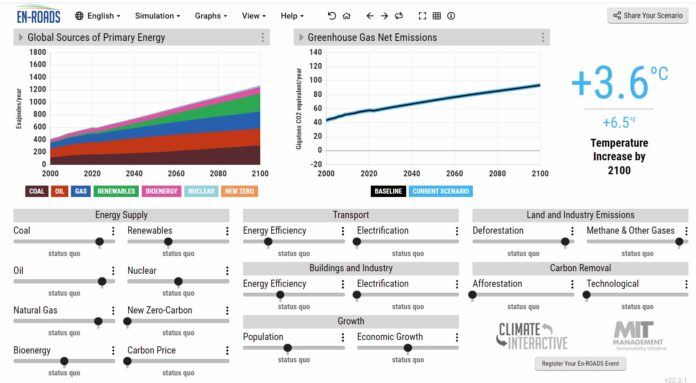En-ROADS and C-ROADS are world climate simulators. How can they be useful to governments in determining which policies to consider for maximum effect? Both are free to users so they can see the long-term impacts of almost any climate policy chosen. In Part 1 of this discussion, we look at En-ROADS.
En-ROADS works well in brainstorming sessions to test enacting specific initiatives related to:
- Type of energy being used, including:
- high-leverage strategies to discourage coal use,
- imposing limits on oil and natural gas,
- recognizing that bioenergy derived from biomass is only zero-carbon if the latter is regrown,
- encouraging renewables through subsidies in the building of solar, wind and geothermal infrastructure including tax incentives to family homeowners installing solar panels,
- the nuclear policy challenge is balancing between its low carbon energy profile and the nuclear waste fission reactors produce,
- the other nuclear options include thorium-based fission and fusion with the challenge for both being the timeline to get these technologies to a commercial-stage.
- Pricing carbon and other energy standards, including:
- creating an escalating carbon tax,
- creating a carbon cap and trade program,
- implementing a clean electricity standard.
- Transportation electrification and energy standards, including:
- expanding public transit,
- increasing the energy efficiency of personal transportation, aircraft, marine, and other means of transportation,
- subsidizing the purchase of net-zero emission transportation options,
- investing in electric vehicle charging infrastructures, battery technologies, and green hydrogen production and distribution,
- creating walking-friendly urban settings.
- Buildings and industry energy efficiencies and electrification, including:
- improving the energy efficiency of existing buildings and homes,
- reducing the energy requirements of manufacturing and other commercial business operations,
- creating new efficiency standards for appliances,
- improving energy efficiency standards in building codes for future construction,
- replacing oil and gas as fuels for heating and cooling buildings and homes,
- researching electrical technologies and systems using renewable sources to replace oil and gas usage in industrial applications,
- electrification and use of green hydrogen for primary manufacturing such as steel, and concrete,
- providing support to research focused on new technologies and materials.
- Population growth, including:
- improving education and access to family planning to accelerate the shift to smaller families globally.
- implementing universal equal rights for women.
- Economic growth, including:
- changing the measuring standard by moving away from gross domestic product (GDP) the way economies today are judged,
- embracing simplicity over overconsumption,
- choosing slower, sustainable growth, and finding new ways to measure well-being and prosperity such as gross national happiness.
- Methane and other gas emissions, including:
- reducing sources of release of methane, nitrous oxide, fluorinated gasses from agriculture, industry, and consumer goods like air conditioners,
- encouraging consumption of plants over animals,
- supporting research in developing new staple crops that reduce the need for nitrogen fertilizer,
- enforcing the plugging of primary and industrial methane and other gas emission leaks responsible for 30% of global greenhouse gas (GHG) emissions.
- Deforestation and Afforestation, including:
- preservation of legacy forests with restrictions on removing trees to clear land for crops,
- restrictions on planting sugar cane, soybeans, corn, and palm oil,
- supporting indigenous land rights and practices that encourage land preservation,
- planting new and restoring old forests ensuring that both are managed.
- Technologies to remove carbon dioxide, including:
- supporting programs focused on carbon dioxide removal (CDR) such as,
- direct air capture,
- enhanced mineralization,
- agricultural soil and carbon sequestration,
- carbon capture and storage (CCS) to deal with legacy fossil fuel sources until they can be phased out,
- increased biochar from pyrolysis,
- banking land for carbon sequestration.
- supporting programs focused on carbon dioxide removal (CDR) such as,
En-ROADS has created a historical data record going back to 1990 so that users of the modelling tool can see how past policy implementations have had both positive and negative implications for the rise in temperatures and concentrations of GHGs in the atmosphere.
Based on current trends En-ROADS (see image at the top of this posting) is trending toward a rise of 3.6 Celsius (6.5 Fahrenheit) in atmospheric mean temperature by the end of this century. That exceeds by far the goal of a 1.5 Celsius (2.7 Fahrenheit) rise, the aspiration of the International Panel on Climate Change (IPCC) as discussed at the Glasgow COP-26 summit late last year.
En-ROADS has been developed by a collaboration of the Massachusetts Institute of Technology (MIT) Sloan School of Management, Climate Interactive, Ventana Systems, and the University of Massachusetts Lowell Rist Institute.
In Part 2 we will look at C-ROADS and how it differs in its measuring of policy impacts on its climate model.
















